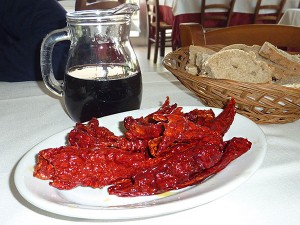If you are not just looking for the hottest peppers, you’ll find a flavorful specialty at the other end of the Scoville scale in southern Italy: Peperoni Cruschi (pronounced crusskee, which means crispy or crunchy).

Peperoni Cruschi as a crispy appetizer

Peperoni di Senise, matured to red
The most popular use, however, is Peperoni Cruschi (pronounced “kruski”), crispy, or crunchy peppers. For this, the sun-dried mildly sweet fruits are briefly fried in olive oil, which makes them even more crispy and flavorful than they are anyway. Then you simply nibble them as an antipasto (appetizer) or use them as an ingredient in typical regional dishes, for example “Baccalà alla Lucana” (Codfish Lucanese style), or various pasta dishes.

Peperoni di Senise fields

Peperoni di Senise in a drying house

Peperoni di Senise: fresh/braised and dried/fried (Cruschi)
Like to know more? We’ll have the second part of Harald’s adventure posted later today.–Editor
The following two tabs change content below.


European Chilehead Editor at Large | Harald’s Chili Pepper Buch 2.0 is the bestselling chile book in German-speaking Europe. He covers European chilehead culture and his own spicy kitchen encounters for Burn Blog.
Latest posts by Harald Zoschke (see all)
- Peperoni Cruschi Part 2 | Frying Them Up - 01/02/2020
- Spaghetti con Peperoni Cruschi - 01/02/2020
- Peperoni Cruschi | Crunchy Treat for Pepper Lovers - 12/31/2019










